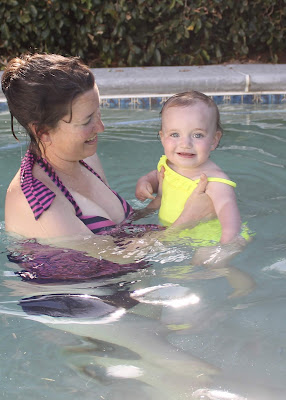There are arguments for and against infant swimming lessons. Some people say that giving infants and toddlers lessons makes them over confident around water and more likely to have a near-drowning experience. Ms. Harmony comes from a state where pools are common and most people believe that specific water skills taught at an early age can make young children SAFER around water. *Children must always be watched around water no matter what age or water experience they have.*
So Baby "K" took advantage of swimming often while she visited her grandparents in Arizona and California! She practiced doing water play almost daily before her trip. This included sprinkler play, water tables, bathing, and baby wading pools. By the time she went on vacation, she had learned to love playing in the water and wasn't bothered if it was a bit cold, or by her face getting splashed and wet. Here are additional skills she worked on in the big pools.
Blowing bubbles: this is a fun giggly way to get young children to "get their mouths wet," leading to eyes and eventually full submersion in the water. Baby "K" worked on closing her mouth when submerged and tried to not snort the water. Children who accidentally fall in water usually fall in face first. If they have experience with getting water in their face, they won't panic as quickly and will be more likely to roll into a back float until they are rescued.
Climbing out from the steps: Baby "K" practiced cruising on the first step and climbing out of the pool from the top step. In the event that a baby falls in, if s/he can get to the steps s/he will be able to independently climb out.
Climbing out from the side: Baby "K" still needs assistance with this skill. We helped her use her arms and legs to pull herself up and out of the pool.
Swimming to the side or the steps: Baby "K" got experience with kicking toward the steps and the wall. When the baby goes under, we want the baby to turn and look for the side or the steps so that they can make it back to safety if a rescuer is not close by. She practiced looking for the side or steps and kicking in that direction with her face getting wet many many times.
Back floats: Baby "K" likes this part of swimming lessons the least, but this is super important. If the young child gets tired or cannot make it to the wall or steps to climb out, they need to roll over and float until they recover strength or until they are rescued. Ms. Harmony helps Baby "K" practice by laying her head on her shoulder with one hand on her back pushing up her belly, and one arm across her chest for security. Then Ms. Harmony sings favorite songs quietly in her ear to help her relax. Over time, the young child will rely less and less on the shoulder and arm for support, and more on the buoyancy of the water. At the conclusion of the float, Baby "K" rolls back over and kicks either to the adult or the side.
Water Play: But one of the most important things to teacher is how to have fun! Baby "K" loves counting to three and being tossed in the air! She progressively splashed deeper and deeper as she learned to tolerate more splashing and water in her face.
Other favorite water games are "Motor Boat Motor Boat" and "Ring Around the Otter."
As a final word: always, ALWAYS, watch your kids around water. But it's okay to let them play in the water and begin learning water safety skills from a young age. Happy Summer!











